The Philosophy of the aesthetic, ambiguous cube
The form as the unity of opposite and the time.
Consequently the painting is nothing else than Philosophy
Leonardo Da Vinci, A Treatise on Painting
If one wants to know what is a form and ask the art system, you receive no uniform response. This is also valid for all related terms like aesthetik, harmony, wholeness, time, boundary, opposites, sculpture/plastic art, object/space, Sign/space. The art system having lost its form. Ambiguous structures can contribute to resolve the problem.
The representation of the ambiguous, bivalent cube is the base element for my ambiguous figures. Both are two-sided forms which can be observed sequentially. We can also call them „selfreferential, visual forms“. They depict the fundamental problem of the the term „form“. They represent a visual antinomy.
Especially within the motion of „cubism“ painters experimented with the same problem of a „sequential form“. E. Gombrich (11) calls the „Thiery Figure“, also an ambiguous figure, as the „quintessence of cubism“. The „Thiery figure“ implemented a time gap within the perception of the cubic pictures. The objects/figures and the surrounding space are constructed based on cubes. We can allocate a viewpoint to each cube. This results in multiple viewpoints – the polyperspective.
We can split the multitude of viewpoints into two classes. Those which represent the object and those which represent the surrounding space.
In this context the motion of cubism extended the perspective to the polyperspective. The unity of an object has been fragmented into multiple parts. Ambiguous figures are creating wholeness and the unity of opposites. The movement of cubism extended the complexity of figures in the space, ambiguos figures compress the complexity.
Ambiguous features, paradoxes and antinomies have fascinated a great number of artists through the centuries, like Magritte, Escher, Dali, Picasso, Sol LeWitt and Vasarely. Aside from in fine and visual arts (1,15), the subject is also discussed in human neuroscience (2,3,13), computer science (4,5,6), mathematics (7,8) and in philosophy and sociology (9,10). Based on E. Gombrich the relationship of ambiguous forms within cubism is also discussed in (12). The connections between the different areas within the issue are shown by D. Hostadter (14).
I investigate the occurring phenomena with a focus on art, philosophy and aesthetics touching mathematics, visual neuroscience, computer science and systems engineering.
The Formproblem
A „form“ is, in a first step, a gathering together into a whole of distinct objects of our perception [Anschauung] or of our thought.
What means „gathering together“, what are „distinct objects“, what is „the whole“? What role do perception and thoughts play? We are going to investigate the issue further observing a cube placed in a space.
According to the classical concept, the cube is a form placed in the surrounding space without any relationship to the space or to an observer. The cube keeps it‘s identity. The concept is timeless. Generally we consider the space as the part which remains if we remove an object. Space is a kind of container, the negation of the object. We can add objects or material in a space which we call plastic art (p). We can subtract from an object material or elements which we call a sculpture (n).
According to the modern understanding, especially in the system theory, it isn‘t possible to fully capture and understand the cube without considering its relation/connection to the surrounding space and the observer. Observing the ambiguous cube makes this problem experienceable and it becomes apparent. The same visual two-dimensional information generates two different perceptions. We interpret them in a three dimensionally way, as a small cubic object in the space, as a plastic art or as a small cubic space that has been cut out of a big cubic object, as a sculpture. The first view/perception is called positive (p), the second one is called negative (n). We cannot recognize the two opposite perceptions at the same time, they follow each other sequentially as a state change Z,Z+. A time gap, which we call dt, seperates them. We appreciate the change emotionally as a surprise. We call this experience, aesthetically. The state change can oscillate. The elements object/space change their meaning. The object becomes the space and the space becomes the object and vice versa. The bounderies inbetween cannot be clearly allocated to the space or to the object. The boundary becomes a two-sided boundary- a form out of „time“, we call it the „interface“.

Ambiguous cube,plastic art or sculpture?
Now we have the three essential attributes for the understanding of the „form“. The cube, the object as the identity A, the space as the negation of the object –A, the boundary as the mediator where the two opposite views (p),(n) and the opposites, the Identity A and the Negation –A meet each other on different sides. We can identify the boundary, where the opposites A and –A flip, as the time gap dt, a process time or as a memory time.
The classical understanding of the form, as an identity A within the space has been decomposed within a sequential process, where the identity A flips over in the negation –A and vice versa.The problem is to bring the sequential process back to the unity of opposite and further gathering together with the time into a whole. We observe the representation of the two-dimensional ambiguous cube as the invariant within the whole process of creation which consists of perception, the analytical thinking and acting. Within this process the antinomy disappears.
With the ambiguous figure, in contrast to the ambiguous cube, the observer can decide which view he wants to see. This is the basis of my ambiguous paintings, in which I present two different figures in one form. This allows the observer to decide freely which figure, the plastic art or the sculpture, he wants to see at which point in time and for how long he wants to see it. In order to do so, he has to emancipate himself from automated evolutionary perception, stored cultural knowledge and has to learn to operate with his perception system.
I come to the conclusion that the resulting figures are metastructures which are changing our point of view from „the object within the space“ to „the object within the space and time“. This leads us to the result that we have to rethink and reunite the philosophy from their roots in order to achieve a future perspective.
Before you read on, I recommend you take a look at the first four pictures and to make them flip over. Afterwards, you should try to stabilize the form. When you have achieved this, you are ready to go on a tour through the ambiguous world with me. Your brain has already achieved a remarkable feat and you, as the observer, have been able to widen your normal view by an additional one. You are able to see scupturally and plastically. In doing so, you have managed to see what you yourself wanted to see. You learned to operate with your perception system.

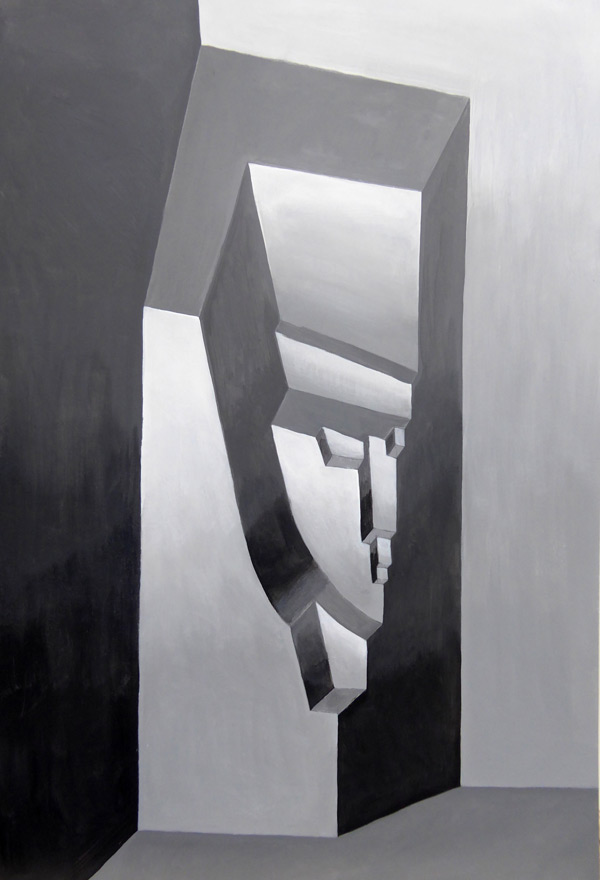
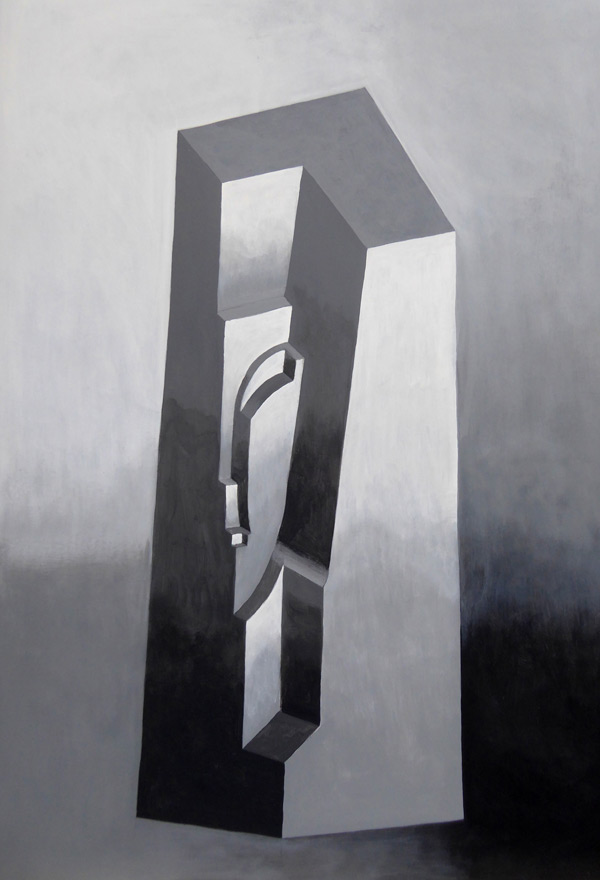
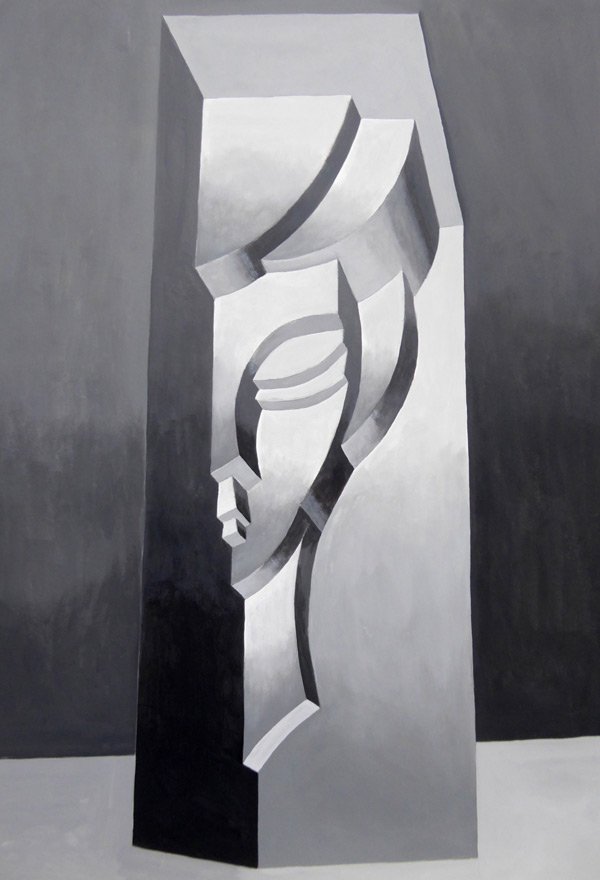
The evolutionary pressure on the senses and the cultural pressure on our knowledge are optimized to keep our world stable and to minimize ambiguity as much as possible. Otherwise, we would probably not survive. You left your backup of evolution and culture behind and are now travelling without a safety belt. It all depends on you and you carry the full responsibility. You can now choose freely between two equal views. This responsibility comes with new boundaries. What you have not seen yet is how to deal with the two seemingly different opposite views and how to unite them and further merge them into a wholeness. We have now marked the area for our trip into the ambiguous world.
The ambiguous cube is already thousands of years old and appears in similar forms in the ancient world, for example within tiles on the floors and on the walls.

Ambiguous cubes in tails at a wall in Sardes, Turkey
The fascinating thing is that one visual information results in two different perceptions or views. You can see cubes in space, but also the opposite. This is a visual analogy to the sentence by Epimenides the Cretan who said:
‘all Cretans are liars’
This sentence is also approximately two thousand years old and it was in a deep sleep until it suddently awoke again approximately 115 years ago. It led a terrible punch against the foundations of our thinking. In mathematics and logic it even caused an earthquake. Until this day, the aftermath can be felt and heard again and again far beyond these areas. The problem is simply based on the fact, that you cannot clearly decide what it is you now see or hear. The Cretan could be a liar or not, the cubes in the picture could be the space or the objects. We cannot say for sure and we cannot see it clearly. The reverberations are continuing until today.
In painting, the movement of cubism was born during a similar time window. Surely, you are surprised: Why are we talking about such a simple sentence or picture in such detail? It also took a long time until these kinds of artforms were given a name at all. Today we call them metaforms, which simplified means nothing else than the picture or the sentence in the example above. They allow for two different interpretations which can both be chosen. There is no preference for any of them. In summary we can ask: How is it possible that one can be two? These two examples, representative of the visual perception (mosaic) or mathematics and logic (liar), rattle at our most stable, most reliable, most trustful and most certain foundations: those of perception and thinking. You may ask further: how is this related to paintings? The answer is as follows: Painting is the most simple, free system, which experiments with forms of perception and their representations. Painting is simple, because it only needs brushes, paint and a medium. It is free, because it can be created by one individual, independent from apparatuses, machines and other things, in a simple space. All combinations of simple signs are possible to create a complex whole. Because of this, it has an affinity to mathematics and logic. In principle, these also only require pencil and paper to create a complex whole based on simple elements. The combination of signs follows specific rules, which is the difference to paintings.
For mathematics / logic, the metaform of the “liar” is until this day a problem that has not yet been fully solved and therefore poses a risk. In painting, the ambiguous form that become visible in the mosaic, contain a new challenge to operate with the perception system and start „visuell thinking“.
The fascination of the examples lies within the form itself and in how we can interpret it. If you look at the form of the mosaic again, you recognize that it only consists of points which are connected to each other. If you interpret them, the points suddenly start to flip and you see cubes or spaces interchanging their meaning with each other. We call this phenomenon the “tipping point“. We are familiar with this term. In the following, I want to show you how we can get the point to flip and what the resulting consequences for us are. Let‘s start with simple forms of painting. We leave the liar to the mathematicians and logicians again. Their formulars are based on strict rules. Our forms, those of painting, are free from rules. We can connect what we want and how we want.
Forms
We now analyze two dimensional forms, so called polygons. They consist of closed lines. If you walk along such a line, you end up at your starting point. Forms have a measure. We can distinguish between irregular and regular forms. Regular forms have a name, irregular forms very rarely have one.

Irregular forms
The following forms, e.g. square, circle and hexagon are symmetrical, two-dimensional forms. The advantage of these kinds of forms is that they allow for fast orientation.

Regular forms: square, circle, hexagon
We select the two-dimensional hexagon. If we concentrate on doing so, we can see three-dimensionally. This results in us seeing a three-dimensional cube. This is the virtual view of the hexagon. The hexagon consists of 7 points and 12 connections. The virtual view is depicted as a projection of the cube. It consists of 8 points and 12 connections. The advantage of these kinds of forms is that they allow for fast orientation. The difference of one point can be recognized in the projection. This means that the cube has some additional information.

Cube, hexagon
In the case that we cannot convince another observer of our virtual view, we can build a real three-dimensional cube made out of wire and count the edges. We can bring the model into a relative position to the observers, so that both have the same view and can agree on what they see. If you talk to an observer about the projection of a cube without having a real wire model available and you ask him what he sees, you will realized that the cube can be interpreted differently (Necker cube). When we see the “tipping point“ for the first time, different observers give different answers as to what is positive / negative, inside / outside, above / below, left or right. Everybody can have a different point of view and all of them are valid. However, you can agree that you are looking at a code and that you can take a decision.
The ambiguous cube
We develop the ambiguous cube by using the asymmetric principle on two symmetrical hexagons.

Development of the ambiguous cube
The ambiguous cube as representation consisting of points and as a graph representation. The ambiguous cube is a modified pattern of the mosaic shown before. We present it as a pattern of points and as a pattern where the points have been connected. The connections are also called relations or relationships. All points and relations together form a network. We see that the representation as points is stable, but nothing is jumping. The points stay only points, stay only points…

The ambiguous cube as points an das graph representation
Only when we observe them as connected points do they start tipping. They start to move and suddenly, we cannot stop it, our perception changes and we perceive another view. The observer shifts the perspective and his point of view. A change of the horizon occurs. We are surprised and astonished, even simple actions can have a big impact. Just as in real life, where a spark can really jump across in relationships. Views can also suddenly change from one day to the next. Networks can tip and in doing so can split into two polar views. We can now say that the essence of the pictures presented is not the individual points presented, it is the presentation as relations. The points alone do not exist in time, they are not alive. It is the relation which provides the force and brings the points to life. In the ambiguous world, the relations are more important than the individual points. However, the precondition for this is the specific form of the ambiguous cube.

The ambiguous cube
Our interpretation of the two perceptions is either a small cube in a space, or a big cube with a small cube cut out. The first perception is called positive (p), the second one is called negative (n). We can see these two virtual opposite views on the left side and on the right side of the ambiguous cube as a plastic art or as a sculpture.

Ambiguous cube with two virtual views
On the representation (middle) both views of the ambiguous cube are oscillating. We cannot see both of them at the same time. We can only see them in a process one after the other. If at one point in time we only perceive one view, we only see 50%, the other 50% disappear. Now we want to look at this in more detail. If at this point in time we see a view, we call this state Z and the following state Z+. There is a jump in time between the two. We call both views together the timeview and we note it as an ordered pair Z,Z+. If we transfer this idea to the oscillating ambiguous cube, we get Z,Z+, Z,Z+,… and we can see that the later view Z+ reacts back to the first view Z. We call this feedback. We now call the process the aesthetic ambiguous cube.
It becomes apparent that we can merge the two views into one unit. However, this is not possible on the picture‘s surface, because the views don‘t exist at the same time, but are only virtual ones in a time sequence in our perception. We have to leave the theoretical surface of the picture and have to move into the real space where we can build the forms. We now see the two “real objects“ standing next to each other. We can unify them into a classical cube with an „inner form.“ We have moved from the theoretical world to the practical world and have translated our virtual opposite perceptions into a real-world unit with an “inner form.“
Unity of opposites, plastic art and sculpture: Two in one
The “inner form“ is the mediator between the two different objects. It can be realized and build in the real world. We also call the mediator ‘cut surface‘, ‘connection area‘ or just the ‘interface.‘ It has complementary characteristics which we will investigate in the following.
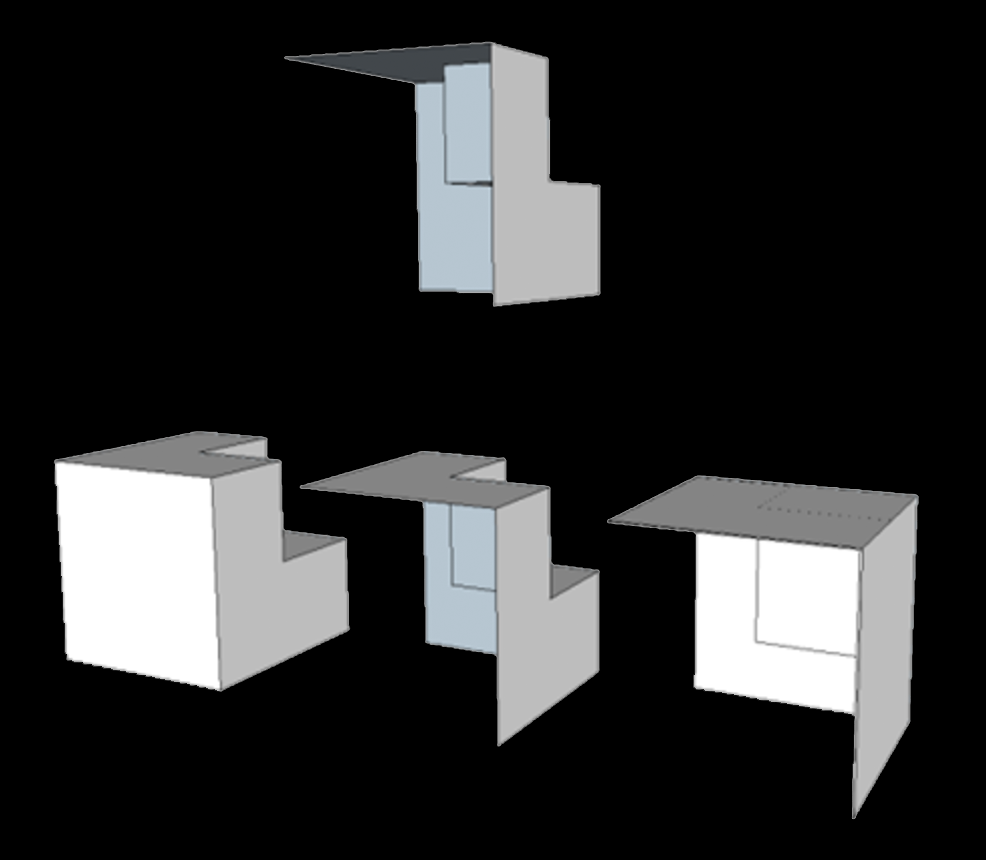
The Interface
If we look at the interface from one side, we see the real view Z and, if we switch, we can see the virtual view Z+. The virtual view Z+ is the real view from the back. Due to these characteristics, it is possible for two observers X,Y on different sides of the form to see the real view of the respective opposite side by seeing the virtual view of their side. This means they can see and understand the other observer‘s side. In addition, they are able to change their position to the other side in order to check if the virtual view from their first point of view really corresponds to the real view of the other side.

Two observer at the interface
The virtual view Z+ of both of the observers X and Y becomes a verifiable prognosis of the future. They can simply prove the predictions by walking around the form and seeing what is on the other side. The virtual views become reality. Before that, they were only potentiality. Compared to other worlds, we achieve a remarkable improvement in the interchanging of views between two observers X and Y. Now we can merge the real interface with the two objects to receive a wholeness. Compared to the unity, where we had a virtual interface as boundary or a „form out of time“ we now have a real one – the realized interface, a two-sided-form with wall thickness. The wholeness is the unity of opposite and the time. The whole is the form. The form is the unity of opposite and the time.
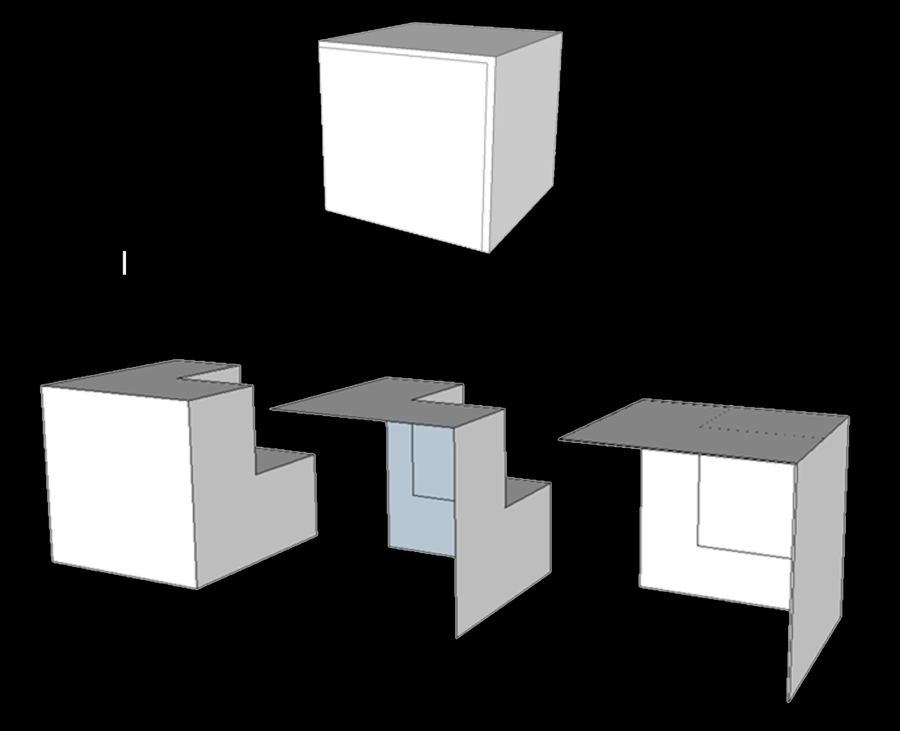
Wholeness: plastic art, time and sculpture. Three in one
The ambiguous figure
An observer can freely and deliberately decide on the view of the ambiguous figure, in contrast to his views of the oscillating ambiguous cube. For this purpose, the observer has to emancipate himself from automated perception and from his stored knowledge. In order to achieve this, I engrave a form into the ambiguous cube, e.g. a face. Due to the fact that the human perception system is familiar with faces, it immediately recognizes faces as a two-dimensional pattern and tries to stabilize them. In the next step it will be possible to see the three-diminsonallity and further the depth ambiguity. In the last step the observer can switch between these views.
The ambiguous figure is an extension of the ambiguous cube. Several cubes are placed together into the corner of a room, to build a staircase-formed structure. Some of the cubes are topological transformed into features such as the eyes, the nose and the mouth. It is, so to speak, a geometric plastically formsystem (p). In the same way we can construct a complementary system where we cut smaller cubes out of bigger ones in order to achieve a staircase formed sculpturally structure (n).
Using the three-dimensional timeview Z,Z+, the observer‘s consciousness is able to decide freely on the next view. His consciousness is extended and becomes a time eye. He operates with his percption system, like a painter or a sculpturer.
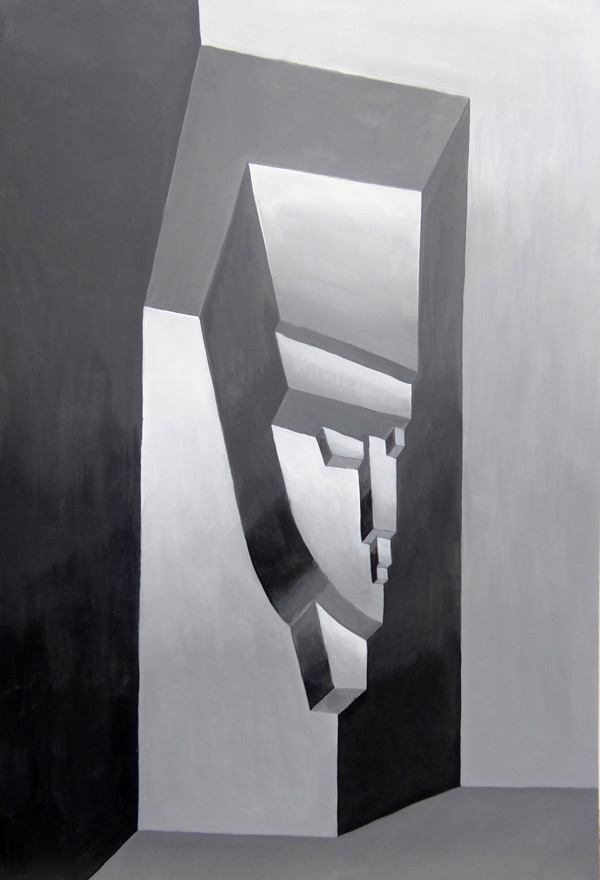
Interface 186
There are two simple possibilities to see the reversal of the two views positiv/negativ in the picture and to train the timeview.
- Possibility: The visuell perception system creates the views. The observer is passiv and looks at the picture with high attention and meditatively. We call this possibility ‘‘bottom up.‘‘
- Possibility: An observer can decide on the view of the ambiguous figure. The conscience creates the views. We call this possibility ‘‘top down.‘‘
With a little bit of training, we can consciously control the picture and stabilize one view over a certain amount of time and jump to the second view when we choose to do so. In contrary to how the oscillating, ambiguous cube works, we can decide when and what we want to see. However, we have to remember, that at any point in time, we only receive 50% of the information the picture contains. The other 50% disappear. The observer has emancipated from his pre-programmed perceptions and the pre-programmed knowledge. Normally, both create stable and constant fixpoints, the categories. The observer is able to turn constants into variables and can operate with his perception system. In summary we can say: Pictures are generating terms and terms are generating pictures. In my paintings, I use the ambiguous two sided-form of the interface and I am creating a first draft in the virtual space of a computer. It shows me that each change on one side results in a change on the other side.
The ambiguous sculpture
The tipping point can also be discovered by an immobile observer in the real world at all corners of a room and edges of objects. This makes it possible to translate this way of seeing things and theoretically ambiguous painting into real sculptures and architecture. Ambiguous sculpture are realized as „Interfaces“ with a spatial wall thickness. As a meeting point in social spaces they offer the possibility to exchange different points of view, to make predictions and to directly verify them. With the timeview Z,Z+, it enables an observer to see both sides of a figure from either of the sides. A one-sided view results in receiving only 50% of the information. Looking at something in its entirety becomes possible if everybody realizes that he can take the other person‘s point of view and verify what this person is seeing. Within an iterative process communication becomes a clear and transparent dialog.
The observer is able to view through the matter and see the figure on the other side.
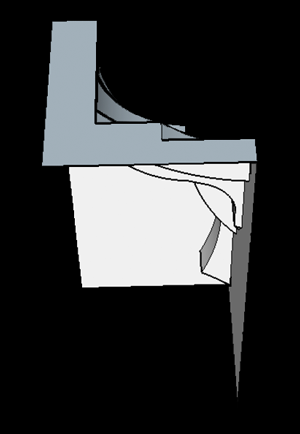
The ambigous sculpture
The ambiguous architecture
If we observe a cubic space where we add different elements like baseplate, colums, stairs and a roof plate, we have created a plastic art house.
If we negate this understanding we receive a house as a sculpture. The space becomes the object and all elements becomes a space.
The ambiguous cube is oscillating and we receive a plastically and sculpturally perception.
We have identified the resulting boundary with the tim-gap which we now give an architectural form.
The interface is hidden in all the cubes on this world, but we cannot directly see it from the outside. Now, with ambiguous architecture, we have opened the cube, we show the „interface“ with a spatial habitable wall thickness and offer the possibility of giving a town two faces in one form. The inside becomes the outside and the outside becomes the inside. The japanese architect Sou Fujimoto is experimenting with similar ideas (15).
The ambigous architecture
The ambiguous harmony
The idea of harmony was born in Greece approximately 2500 years ago. A process of rethinking started. People stopped believing the stories their predecessors told and an independent way of thinking developed. This was based on the principle of „Know theyself“ and to make one‘s thoughts verifiable for oneself and others.
The term „harmony“ was based on Pythagoras‘ observations of music. According to legend, he discovered, based on the monochord, that one string leads to sensorially and acoustically perceivable, agreeable tones if it is divided by integers. The monochord can be used to illustrate the mathematical properties of musical pitch and to illustrate Mersenne‘s laws regarding string length and tension: “essentially a tool for measuring musical intervals.“ For example, when a monochord string is open, it vibrates at a particular frequency and produces a pitch. When the length of the string is halved and plucked, it produces a pitch an octave higher and the string vibrates at twice the frequency of the original (2:1). The pitches were beautiful and harmonious and Pythagoras decided that whatever scientific law caused this to happen, must be a mathematical one and could be applied to music. If it is at a ratio of 1 to 2, this results in an octave, if the ratio is 2 to 3, we perceive a fifth, if the ratio is 3 to 4, this results in a fourth. Tones and numbers mutually correspond to each other. This could be tested geometrically and people could agree on it. The individual tones are the basis of music and are ordered chronologically. This result connected the acoustic, sensoric perception with the intellectual, mathematical way of thinking about numbers. It enabled us to hear the idea of mathematics. The consequence of this connection has been enormous. The complete occidental tradition of music evolved from it and it also made it possible to connect human emotions with acoustic perception and mathematics. Harmony was born.
The Greek philosopher Heraklitus attempted to define the concept of “harmony“ in dialectal terms as the unity of opposites: “Opposition brings concord. Out of discord comes the fairest harmony.“
The idea of harmony and how it can be experienced sensorially through our ears, has been transformed into proportional relationships between straight lines, areas and cubes. From there it has been translated into the visual arts like painting, sculpture and architecture. The golden ratio, which is based on geometrical relationships, is a typical example. The resulting harmony based on proportions was visible in buildings and in mosaics on walls and on floors. Visibility is conveyed via the eyes. Mathematics, ears, emotions, philosophy and eyes were connected through the concept of harmony. The term “harmony“ have now been theoretically compressed into the following definition: “Harmony is the unification of opposites to a wholeness.“ Form, harmony and the wholeness refer to the same thing. We recognize harmonic creations as beautiful, which makes harmony and aesthetics go hand in hand. Aesthetics is the study of perception or, in our case, visual perception. Something is aesthetic if it moves our senses when we look at it: something beautiful, something ugly, something pleasant or something uncomfortable. Harmony and aesthetics have been an essential part of occidental thinking and perception. Within visual (pictorial) art, such as painting, sculpture or architecture, harmony and aesthetics have lost their validity. They had been found to be too subjective. We ask ourselves “why‘‘? The terms of harmony and aesthetic have evolved out of music because of Pythagoras. Music is a kind of art which is based on the concept of a chronological sequence of tones. Music is able to cause a change in our sensory perception.
The classical visual (pictorial) art forms are unable to do so. They are based on timeless, stable forms which remain in one state of being. An immobile observer cannot recognize any change of the form at all. A square remains a square. This is also valid for irregular forms. Forms are timeless and motionless. Time does not play any role. The concept of aesthetics and harmony which has been transferred to the visual arts was an analytic one which could not move the senses.
But how can we get motion and time into the visual arts? How can we present opposites in unity in order to satisfy the definition of “harmony“ as stated above? Ambiguous figures make this possible. One single visual information generates two opposite perceptions at two different points in time. We described this as time view Z,Z+. Our visual perceptions change, opposites (plastic art/sculpture) are connected aesthetically through time to a wholeness. Recent research on the Necker cube in neuroscience showed that the tipping of perception is measurable within our brain and can be verified. The interface, the mediator, plays a particular role within our concept. Our interface is comparable to the point of Pythagoras, which divides a straight line. The interface and the point are in between two opponents and connect both with each other.
The ambiguous language
In order to give expression to these experiences of seeing, we need a new visual language of architecture and art. This builds on the two-dimensional cube, the plastic and the sculpture.
We need the language to communicate and to understand each other. In order to speak it is essential to know their axiom, their symbols and their rules. Their axiom, the principle, and the first symbol we refer to, is the two-dimensional ambiguous cube. Their symbols are the ambiguous two-dimensional cube, the plastic and the sculpture.
The rules indicate how one symbol is converted into another. The transformations are performed by our visual system, which we can directly influence. The four most important transformations we can perform with our visual system are:
- The transformation of a two-dimensional perception into a three-dimensional, either plastic or sculpture (2D → 3D).
- The inversion, the transformation of a three-dimensional perception into a two-dimensional (3D → 2D).
- The transformation of a three-dimensional plastic perception into a sculptural one (P → S).
- The inversion, the transformation of a three-dimensional sculptural perception into a plastic one (S → P).
Now we can combine these arbitrarily, e.g. with the change from the two-dimensional representation to the plastic or sculpture. Conversely, we can change from the two three-dimensional representations of plastic or sculpture into two-dimensional representation. The conversion process is temporal one, which we depict as a pair, the first place always indicates the first time point and the second place the follow-up time. Visual language is a subjective formal language of sensory visual perception. This allows us to communicate clearly when and how we perceive ambiguity.
The ambiguous logic
The ambiguous cube also plays a special role from a logical perspective. We can see him primarily as plastic or sculpture. Through this ambivalence we can not say exactly what he actually represents. He is thus, so to speak, the visual form of the paradox of Epimenides the Cretan, who said: “All Cretans are liars” and thus presents us with the difficulty of not knowing whether he is lying or telling the truth. The problem is undecidable or ambiguous, as is the ambiguous cube, whether it is a plastic or a sculpture.
The undecidability or ambiguity is the basis of our new formal visual language of architecture and art. It begins where the classical formal languages of the word and number have found their limit. Their axioms are the logical laws that have been valid since Plato and Aristotle. They are based on the identity, no contradiction or a middle one is allowed. We overcome this by observing the ambiguous cube, the axiom of our new language, on the basis of a temporal logic, in which, as already mentioned, we designate the change from one perception to the other as the aesthetic event. We cancel the oscillation between the perceptions by leaving the theoretical two-dimensional plane in which we represented the ambiguous cube and putting ourselves into the threedimensional practice. There we reconstruct the contradictions of the plastic and the sculpture, allocate a seperate point in time for plastic and sculpture and join them together in one unit. We call this, following Heraclitus, the unity of opposites, or simply harmony. Once we have assembled the opposites into a unity, we discover the boundary as the time that was necessary in the visual cognition process for the transition from plastic to sculpture. We also build the boundary and insert it between the opposites. We receive the whole, the form or beauty. The whole thing is based on the artistic ability to see the same thing as an alternative. This ambiguous logic follows the clear formal logic of word and number.
Vision
The representation of three-dimensional objects on a two-dimensional surface or the creation of plastic arts (p) and sculptures (n) requires first and foremost the capeability of an operating view.
The differentiation of these art forms within the art system is for us an evidence that conscious view changes like 3D/2D or p/n are possible.
Ambiguous metastructures (12) enable us an operating viewing and thinking. Aesthetics, harmony and beauty are the routes and values we can all agree on. The terms allow us a neutral dialog beyond the oppositions.
In China people say:
“All things have three sides. One side I cannot see, the other you cannot see and one which is there and we both cannot see it,“
For the art system it is a new constructive challange.
See for yourself
Remark 1
The ambiguous cube allows the interpretation that a small cube is floating above a bigger one or that a small cube is floating in the corner of a room. However, both forms don‘t oscillate in our perception. In addition, the ambiguous cube can also be interpreted as a projection of a four dimensional hypercube. I will discuss this in due course in another document with another form.
Remark 2
I mainly describe the advantage of the ambiguous cube which is self referential. But there are also risks of mental disorientation. I‘m suggesting you be careful when experimenting with it (see Ref. 4).
References:
- Verena Krieger, Rachel Mader, hg, Ambiguität in der Kunst, 2010, Böhlau Verlag Köln-Weimar-Wien.
- Bach M. (2014). Optical illusions and visual phenomena. Retrieved 22.08.2014 from http://www.michaelbach.de/ot/ Google Scholar
- Kornmeier J., & Bach M. (2012). Ambiguous figures—what happens in the brain when perception changes but not the stimulus. Frontiers in Human Neuroscience, 6: 51, 1–23. doi:10.3389/fnhum.2012.00051 Google Scholar Medline
- Hendrik Barendregt, Reflection and its Use with a focus on languages and lambda calculus, ftp://ftp.cs.kun.nl/pub/CompMath.Found/biologen.pdf .
- Henk Barendregt, Antonino Raffoneb, Conscious cognition as a discrete, deterministic, and universal Turing Machine process*, http://www.cs.ru.nl/~henk/tm2.pdf
- Thomas Bolander, Self-reference and Logic, 2005, http://www.imm.dtu.dk/~tobo/essay.pdf
- Gottlob, Frege, Die Grundlagen der Arithmetik, 1987, Reclam Verlag.
- Alfred N.W. Whitehead, Bertrand Russel, Principia Mathematica, 1986 Suhrkamp.
- Dirk Baecker, hg. Probleme der Form, 1993, Suhrkamp.
- Dirk Baecker, hg, Kalkül der Form,1993,Suhrcamp.
- Ernst H. Gombrich, Kunst und Illusion, 1977, Belser Verlag.
- Teuber, Marianne L.: Formvorstellung und Kubismus oder Pablo Picasso und William James, in: Kubismus. KünstlerThemen-Werke 1907- 1920. Hrsg. Siegfried Gohr. Kat. Ausst. Köln. Bonn I Genf 1982
- Give Me Gestalt! Preference for Cubist Artworks Revealing High Detectability of Objects Claudia Muth, Robert Pepperell and Claus-Christian Carbon Leonardo Volume 46 | Issue 5 | October 2013
- Douglas R. Hofstadter, Gödel-Escher-Bach, 1985, Klett Cotta.
- Niklas Maak, Wohnkomplex, Warum wir andere Häuser brauchen, 2014, Hanser
- Ästhetik der Ambiguität, Christoph Bode, 1988, Niemeyer Tübingen
- Das Paradox, Roland Hagenbüchle, Paul Geyer, 2002, Verlag Königshausen & Neumann
- Architektur? Mathematik! Peter Hettich, Frankfurter Allgemeine Zeitung 20180108 -Seite 13


